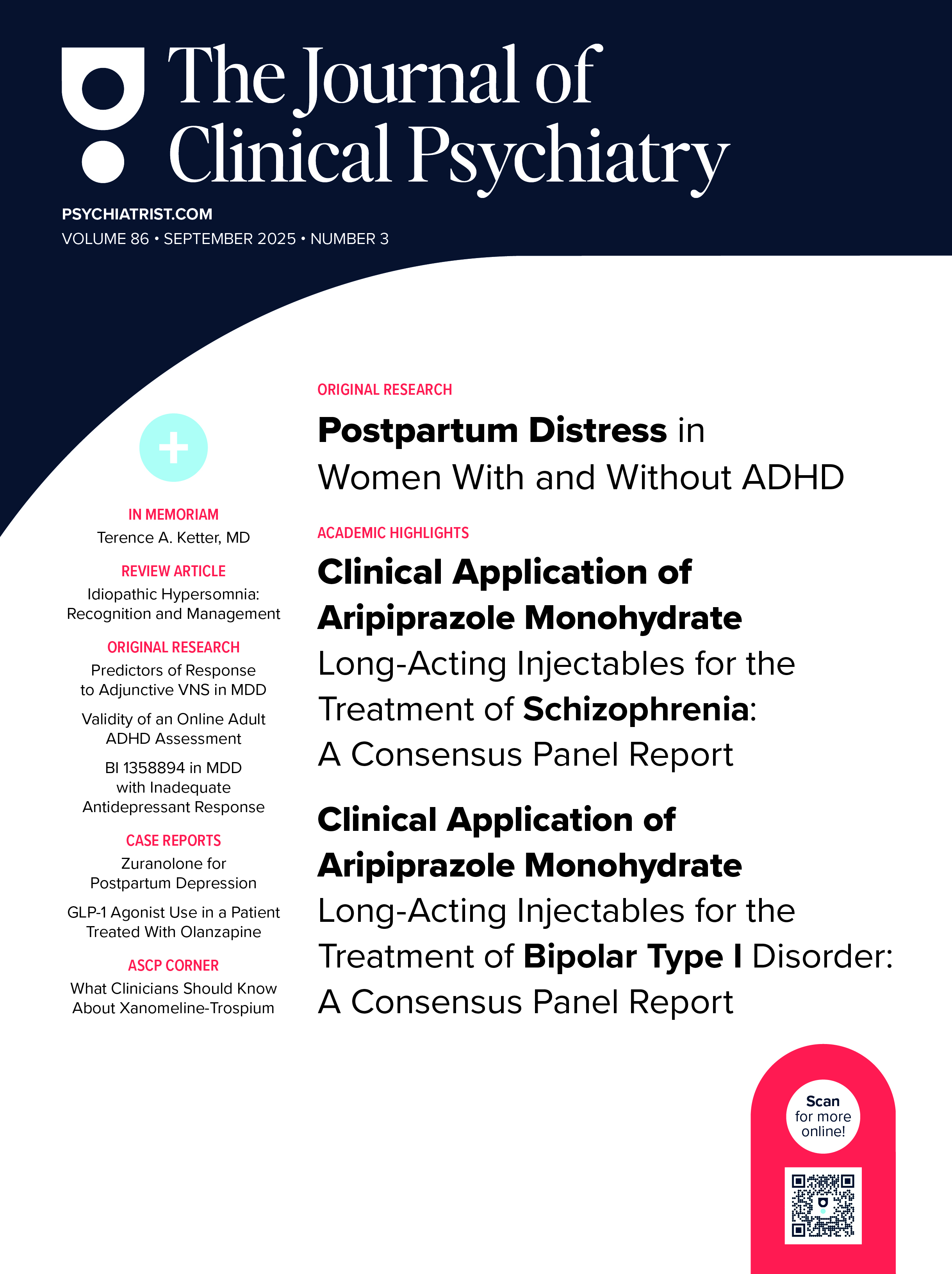Because this piece does not have an abstract, we have provided for your benefit the first 3 sentences of the full text.
To the Editor: As representatives of the Clinical TMS Society, a professional organization representing approximately 400 providers of repetitive transcranial magnetic stimulation (rTMS) therapy from a variety of practice settings, we welcome the recent publication of consensus recommendations for rTMS treatment of depression developed by the National Network of Depression Centers (NNDC) and the American Psychiatric Association Council on Research (APACR). It is auspicious that this set of consensus recommendations comports highly with our own society’s consensus recommendations published in 2016. The high degree of concordance between them is an indication that the clinical practice of treating depression with rTMS has matured significantly since the first FDA clearance of a TMS device for major depression in 2008 and signals that the basic features of a standard of care has emerged for this modality of depression treatment.
This work may not be copied, distributed, displayed, published, reproduced, transmitted, modified, posted, sold, licensed, or used for commercial purposes. By downloading this file, you are agreeing to the publisher’s Terms & Conditions.
See reply by McClintock et al and article by McClintock et al
Roles and Qualifications of TMS Treatment Team Members
To the Editor: As representatives of the Clinical TMS Society, a professional organization representing approximately 400 providers of repetitive transcranial magnetic stimulation (rTMS) therapy from a variety of practice settings, we welcome the recent publication of consensus recommendations for rTMS treatment of depression developed by the National Network of Depression Centers (NNDC) and the American Psychiatric Association Council on Research (APACR).1 It is auspicious that this set of consensus recommendations comports highly with our own society’s consensus recommendations published in 2016.2 The high degree of concordance between them is an indication that the clinical practice of treating depression with rTMS has matured significantly since the first FDA clearance of a TMS device for major depression in 2008 and signals that the basic features of a standard of care has emerged for this modality of depression treatment.
However, the NNDC/APACR paper provides surprisingly little specific guidance on the appropriate role of the physician in the TMS treating team. Our position, which is delineated in our 2016 consensus recommendations,2 is that the prescribing TMS physician is responsible for obtaining informed consent and assessing a patient’s suitability for rTMS, although we disagree that this routinely requires a full physical examination. The physician is also ultimately responsible for the overall daily management of the TMS treatment and should regularly review the clinical course of treatments to determine if the treatment plan remains appropriate or needs modification.
Regarding qualifications for the TMS physician, we believe that the NNDC/APACR recommendation that he or she be “a clinician with prescriptive privileges who is knowledgeable about, trained, and credentialed in rTMS” is too broad. It is our current position that for all rTMS indications, the TMS physician should have the extensive background in brain physiology that is obtained during residency training in psychiatry, neurology, or neurosurgery. The physician should also have a deep understanding about the neurophysiological effects of rTMS and certification in administration of rTMS. Moreover, the complex psychiatric status of the typical patient undergoing rTMS for depression (chronic, severe, resistant to medication and therapy, and commonly comorbid with other psychiatric conditions) warrants that when the indication is depression, the TMS physician should be a psychiatrist or one of the other medical brain specialists collaborating very closely with a psychiatrist in the patient’s treatment.
With regard to the qualifications of the TMS operator, we agree with the NNDC/APACR recommendations that he or she should be trained to recognize and effectively respond to seizures. However, we do not agree that operators should have professional medical training. The last 8 years has revealed that rTMS treatment is very safe and seizures are rare. Furthermore, the limited actions expected of first responders to a seizure in an office setting can readily be acquired by nonmedical office staff. Because of the complexity of the typical mood disorder patient undergoing TMS for depression, we feel that knowledge of and experience with mental illness may be more relevant for TMS operators and that training them to recognize potentially serious changes in a patient’s mental status and know when to alert an attending physician is as important as training on seizure management.
References
1. McClintock SM, Reti IM, Carpenter LL, et al; National Network of Depression Centers rTMS Task Group, American Psychiatric Association Council of Research Task Force on Novel Biomarkers and Treatments. Consensus recommendations for the clinical application of repetitive transcranial magnetic stimulation (rTMS) in the treatment of depression. J Clin Psychiatry. 2018;79(1):16cs10905. PubMed CrossRef
2. Perera T, George MS, Grammer G, et al. The Clinical TMS Society consensus review and treatment recommendations for TMS therapy for major depressive disorder. Brain Stimul. 2016;9(3):336-346. PubMed CrossRef
aKadima Neuropsychiatry Institute and University of California San Diego, La Jolla, California
bCenter for Anxiety and Depression, Mercer Island, Washington, and Department of Psychiatry and Behavioral Sciences, University of Washington, Seattle, Washington
cBerenson-Allen Center for Noninvasive Brain Stimulation, Cognitive Neurology Unit, Department of Neurology, Beth Israel Deaconess Medical Center, Harvard Medical School, Boston, Massachusetts
Potential conflicts of interest: Dr Feifel has received grant/research support from Brainsway and Neosync. Drs Dunner and Press report no potential conflict of interest.
Funding/support: None.
J Clin Psychiatry 2018;79(1):17lr11887
To cite: Feifel D, Dunner DL, Press DZ, on behalf of the Board of Directors and Clinical Standards Committee of the Clinical TMS Society. Roles and qualifications of TMS treatment team members. J Clin Psychiatry 2018;79(1):17lr11887.
To share: https://doi.org/10.4088/JCP.17lr11887
© Copyright 2018 Physicians Postgraduate Press, Inc.
This PDF is free for all visitors!





